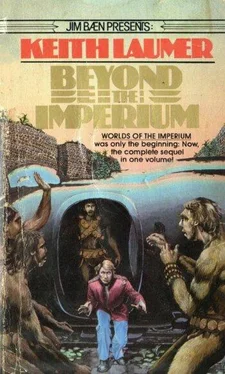“The Seine,” Bayard said. He studied the illuminated chart that unrolled on a small screen before him, with a red dot in the center that represented our position.
“The indicator is reading in the red now. Not much farther.”
Ahead, the river curved between high banks. At the widest point, there was a steep, tree-covered island.
“Does any of this look familiar to you?” Bayard asked.
Have you ever been here before?”
“No. It doesn’t look like much. A river, and an island.”
“Not just an island, Mr. Curlon,” Bayard said. “Take a closer look.” There was a note of suppressed excitement in his voice.
I here’s a building,” I said. I could make it out now: a massive pile of stone, topped by castellated towers.
“A rather famous building—known as Chateau Galliard,” Bayard said. He glanced at me. “Does the name mean anything to you?”
“I’ve heard of it. Pretty old, isn’t it?”
“About eight hundred years.” All the while we talked, the shuttle was gliding in across the river, toward the stone walls and towers of the fortress. Bayard adjusted levers and we stopped, hanging in empty air about fifty feet from the face of the high wall. There was ivy growing there, and in the spaces between the dark leaves the stone looked as old as the rocks below.
“We’re within five hundred feet of the center of resonance.” Bayard said. “It’s somewhere below us.” The wall in front of us slid upward as the shuttle dropped vertically. There were narrow loopholes in the stonework, between weathered buttresses that gripped the rockface like talons. We leveled off at the base of the wall.
“Our target is some twelve feet below this point, and approximately sixteen feet to the north-northeast,” Bayard said.
“That puts it somewhere in the foundations,” I said. “It seems we’re Out of luck.”
“You’re about to have another unusual experience, Mr. Curlon,” Bayard said. “Hold on to your equanimity.” He flipped a switch. The view on the screen faded into a sort of luminous blue, the color of a gas flame, and about as solid-looking. He moved the controls, and the ghost-wall slid upward. The line of rubble that was the surface slid past, like water rising over a periscope, and the screen went solid blue, with clearly defined stratum lines running across it at an angle. There were a few embedded stones, a darker shade of blue, like lumps of gelatin floating in an aquarium, some gnarled roots, pale and transparent, pieces of broken pottery. The screen went darker, almost opaque.
“We’re into the solid rock now,” Bayard said in a tone as calm as if he were pointing out movie stars’ homes. We stopped, and I felt a few million tons of the planet pushing in at me. It gave me a strange, insubstantial feeling, as if I were nothing but a pattern drawn in smoke, like the gaseous granite just beyond the thin hull.
“As I said, quite a machine,” I grunted. “What else will she do?”
Bayard showed me a faint smile and touched the controls. The texture of the rock swirled around us like muddy water with a dim light shining through it. We eased forward about ten feet, and slid out through a wall and were in a small room, stone walled and floored, windowless, thick with dust. It was almost bright here, after the trip through the rock. There were things in the room: the tattered shreds of a rotted tapestry on the wall, a wooden bench, crudely made from rough planks, heaped with dust; some metal plates and mugs ornately decorated with colored stones, pieces of gaudy jewelry, lumps of rusted iron.
“I think maybe we’ve found something, Mr. Curlon,” Bayard said, and now he didn’t sound quite so calm. “Shall we step out and have a closer look?”
Bayard did things with his levers and a soft hum I’d forgotten I was hearing ran down the scale, and the scene on the viewplate faded, as if a projector had been switched off. He snapped another switch and a harsh white light glared against the bleak walls, casting black shadows in the corners. The panel slid back and I stepped out after him. The dust was a soft carpet underfoot; the odor of age in the air was like all the musty books in all the forgotten libraries.
“An old storeroom,” Bayard said in the kind of hushed voice that went with a disturbed grave. “Sealed up, probably centuries ago.”
“It could do with a sweeping,” I said.
“The cloth and wood and leather have rotted away, except for the heavier pieces. And most of the metal has oxidized.”
I stirred a heap of rust with my foot. A flake the size of a saucer crumbled off. Bayard went to one knee, poked at the corrosion, lifted the curved piece clear.
“This is a genouillère,” he said. “A knee guard; part of a suit of chain armor.”
He had an instrument like a Geiger counter in his hand, with a pointer on a cable that he aimed around the room.
There are extraordinary forces at work here,” he said. “The Net tension reading is off the end of the scale.”
“Meaning?”
“The fabric of reality is stretched to the breaking point. It’s almost as if there were a discontinuity in the continuum—a break in the entropic sequence. Forces like these can’t exist, Mr. Curlon—not for long—not without neutralization!”
He changed the settings on the gadget he was holding, swung around to point it at me.
“You seem to represent the focus of a strongly polarized energy flow,” he said. He came closer, pointed the instrument at my face, waved it down across my chest, stopped with the thing aimed at my left hip.
“The knife,” he said. “May I see it?”
I took it out and handed it over. It was nothing much to look at: a wide, thick blade, about a foot long, ground to a rather crude point, with a stubby cross-guard and an oversized, leather-wrapped handle. It wasn’t the handiest scaling knive in the world, but I’d had it a long time. Bayard held the metal pointer against it and looked incredulous.
“Where did you get this, Mr. Curlon?”
“I found it.”
“Where?”
“In a trunk, in an attic, a long time ago.”
“Whose trunk? Whose attic? Think carefully, Mr. Curlon. This may be of vital importance.”
“It was my grandfather’s attic, the day after he died. The trunk had been in the family a long time; the story was it belonged to a sea-faring ancestor, back in the eighteen hundreds. I was rummaging in it and turned the knife up. I kept it. I don’t know why. It’s not much, as knives go, but it seemed to fit my hand pretty well.”
Bayard looked closely at the blade. “There’s lettering here,” he said. “It looks like Old French: Dieu et mon droit.”
“We didn’t come all this way just to study my knife,” I said.
“Why keep calling it a knife, Mr. Curlon?” Bayard said. “We both know better.” He gripped the hit of the weapon and hefted it. “It’s much too massive for a knife, too clumsy.”
“What would you call it?”
“It’s a broken sword, Mr. Curlon. Didn’t you know?” He offered it to me, hilt first. As I took it, Bayard looked at his dials. “The reading went up into the blue when you took it in your hand,” he said in a voice that was as taut as a tow-cable.
In my hand, the hilt of the knife seemed to tingle. It tugged, gently, as if invisible fingers were pulling at it. Bayard was watching my face. I felt sweat trickle down across my left eyebrow. Hackles I didn’t know I had were trying to rise. I took a step and the pull became stronger. A vivid blue spark, like static electricity, played across a lump of rusted iron on the bench. Another step, and a faint blue halo sprang up around the end of the knife. From the corner of my eye, I saw that objects all around the room were glowing softly in the gloom. Dust trickled from the bench; something stirred there, rotated a few inches, stopped. I took a step sideways; it pivoted, following me.
Читать дальше












